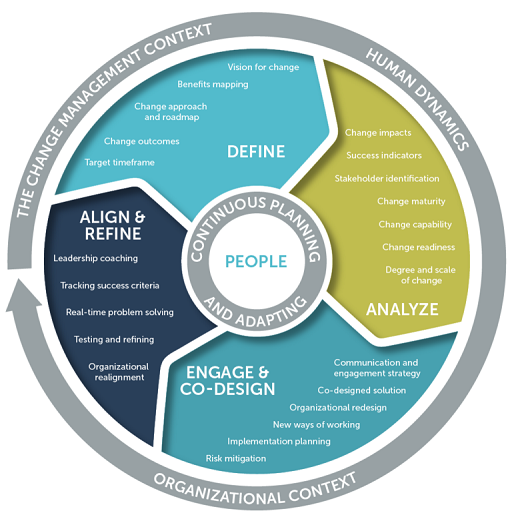3.2 Using a change framework
While some incremental or small changes do not require a formal approach, having an understanding of change frameworks can help to ensure successful outcomes. Later in this course, as your understanding of change management develops, we introduce frameworks that can be used for complex or large change initiatives. They will build on the principles of the frameworks below that can be used for underpinning most approaches to change.
The Change Management Institute (CMI)’s ‘Change practice framework’ (CMI, 2022a), shown below, focuses on four dimensions – define, analyse, co-design and refine. This is a circular process and needs to be underpinned by the context for change, your organisational context and your people. The ‘Hybrid ways of working: a contextual sustainability framework’ (which you came across in the introduction to this course) breaks this down further to ensure the connections and interdependencies across the organisations are fully considered.
This CMI framework provides a useful visual representation of the areas to consider, and the circular process. It is designed for change managers as part of The change management body of knowledge (CMBoK™) [Tip: hold Ctrl and click a link to open it in a new tab. (Hide tip)] (CMI, 2022b).
We have simplified the CMI framework for the purposes of this course to take you through the key steps for change. The steps below provide a summary of elements you need to consider, but they are not exhaustive – you may have other elements you would like to add. We propose:
- Step 1: Assessing
- Step 2: Leading
- Step 3: Managing
- Step 4: Sustaining
Step 1: Assessing
Identifying options for change and building a shared understanding of the right change to make. There are many different activities that can be used to assess change, from those that surface barriers to change to those that identify new opportunities for change and those that help to enable change.
Tasks:
- Problem analysis – Why is there a need for change?
- Impact desired – What does success look like?
- Benefit – What will the benefits be?
- Type of change required – How complex is it?
- Readiness for change – Reflect on the ‘Hybrid ways of working: a contextual sustainability framework’ (see the introduction to this course)
- People – How will this impact them?
- Ability to problem solve – Who will you need?
- Organisational design – What is the context?
- Process design – How will you approach this?
- Experience design – What will it feel like?
Step 2: Leading
Actively promoting the vision and direction of change and influencing others to achieve buy-in. This is achieved by ensuring strategic alignment of the change is reflected in the scope and requirements, effective governance and accountable decision making, and building a team with the right people with the right skills. It is also about working to understand the people and culture and the extent to which they are ready for change.
Tasks:
- Change initiative business case – Do you have an agreed-on case for the change initiative?
- Strategic alignment – How will you ensure alignment to strategy?
- Leadership and vision – Who will provide the leadership and vision?
- Governance – What are the requirements to ensure successful delivery?
- Change team – How will it operate; how will you lead it?
- People – How will you support them through change?
- Culture – Will a cultural change be required?
- Scope and requirements – Who, What, Where, When, How and Why?
Step 3: Managing
Coordinating and overseeing the day-to-day change and project management activities that help to move people from a current state to a future state. These activities include everything from planning and running a project to engaging with people to helping mitigate resistance to change. Assurance activities can help to facilitate change by providing evidence-based information and learning, to projects and programmes, to supporting decision making.
Tasks:
- Communication – What is the approach to communication?
- Planning – What planning will be required, how will this be approached and how will you ensure you can deliver the change initiative?
- Dependencies – What/who needs to be considered for success?
- Strategic alignment and benefits – How will you ensure you meet these?
- Stakeholder management – How will you do this; what are their needs?
- Change team – How will you manage the team and external suppliers?
- Change control – How will this be monitored and implemented?
- Risks and issues – How will these be captured and resolved?
- Self-management – What will you need, and how will you manage your own wellbeing?
- Implementation – What will be need as you implement the initiative?
Step 4: Sustaining
Ensuring that changes are sustainable and achieve the desired benefits and impact through effective transition management and implementation. Supporting people with appropriate training and providing mechanisms that reinforce continuous learning throughout the project cycle will also increase the chance of change sticking for the long term. This is important for ensuring people do not revert back to old ways of working.
Tasks:
- Impact analysis – How do you monitor the impact – what evidence will you require?
- Benefit realisations – How will you know these have been achieved?
- Training support – What training will be needed long term?
- Continuous learning – How will you capture the learning and use it in the future?
- Transition management – How will you know this is business as usual, and what ongoing activities will require support?
- What next?

